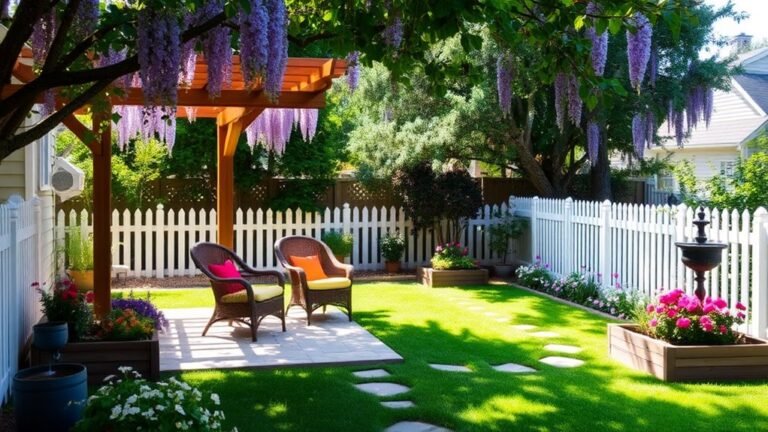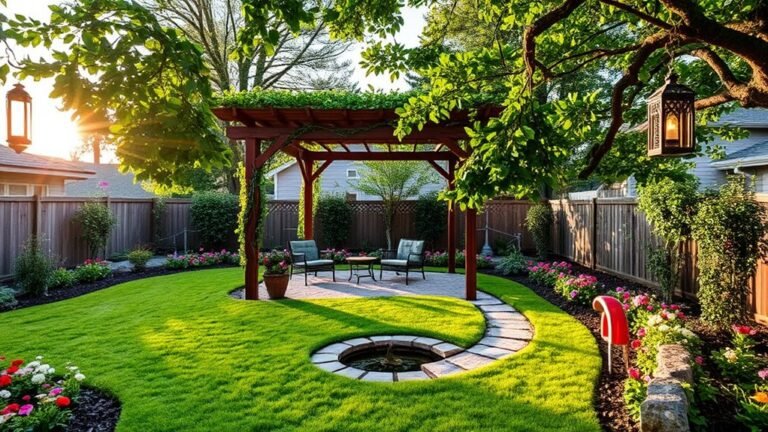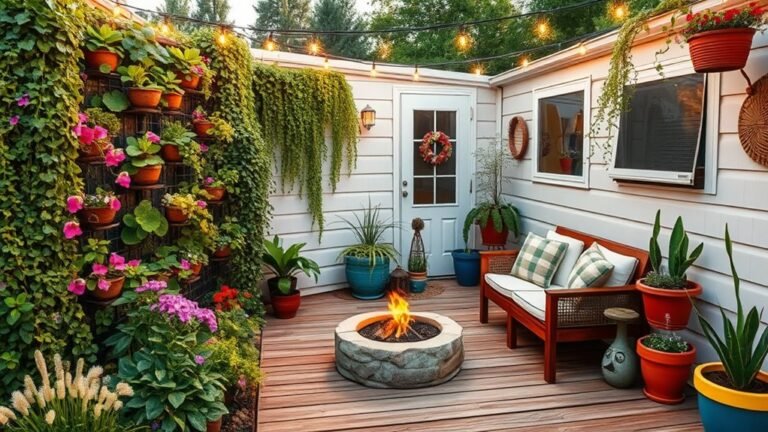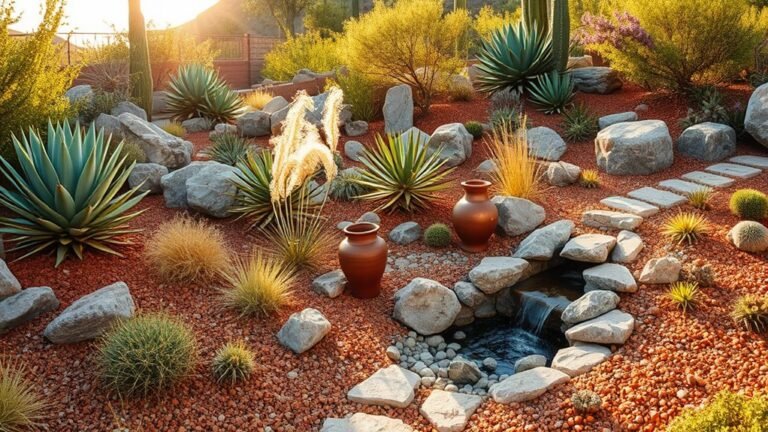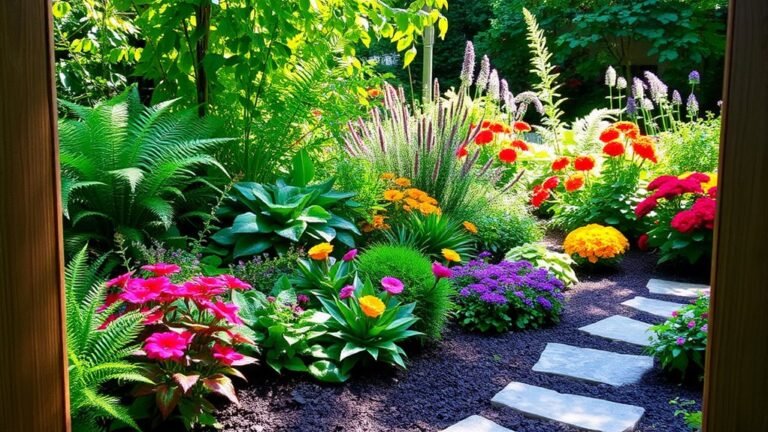14 Backyard Farming Ideas for Fresh Produce
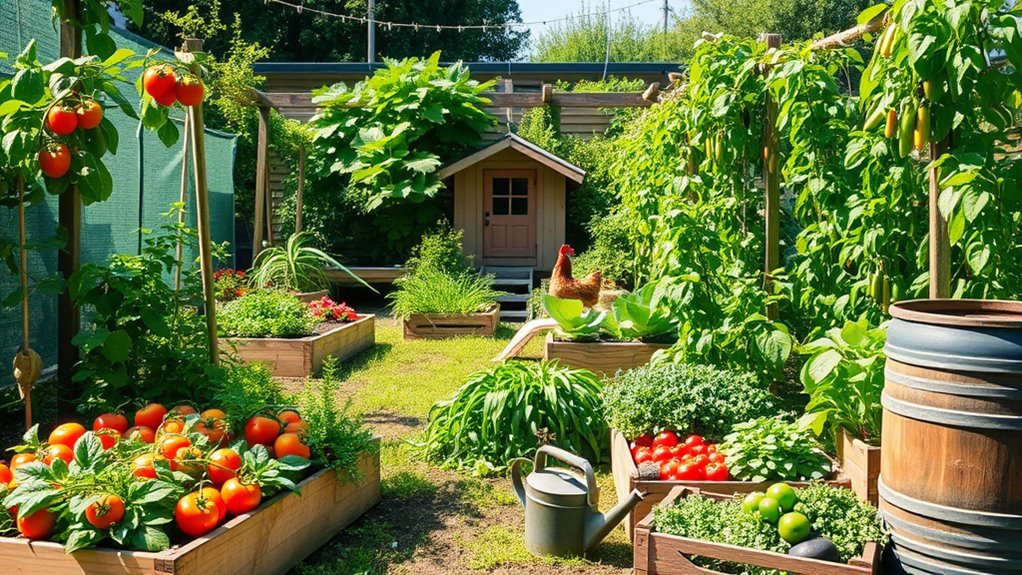
Backyard farming can be both manageable and rewarding, even in limited spaces and with busy schedules. With strategic changes, you can enjoy the convenience of fresh produce right from your yard.
Imagine stepping outside to harvest ripe tomatoes or aromatic herbs whenever you wish. Let's discover practical backyard farming ideas that are adaptable to any lifestyle.
Raised Bed Gardening
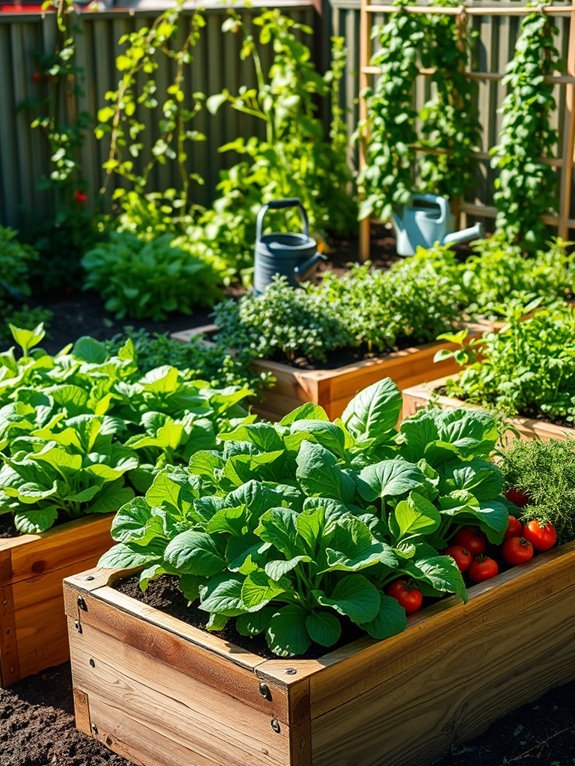
Raised bed gardening is an effective way to maximize your gardening space and reduce maintenance efforts. With a dedicated area in your yard for fresh veggies, herbs, and flowers, building raised beds enhances drainage and soil quality, leading to healthier plants.
You can adjust the height of your beds for easier access, eliminating the need to bend down excessively while weeding. Additionally, the soil in raised beds warms up faster, allowing for an earlier growing season—it's a clear advantage!
Using quality soil in your beds ensures your plants thrive, akin to a luxury spa day for your veggies. A well-planned layout can accommodate your favorite crops.
Explore companion planting—some plants thrive together, while others do not. Keep it fun and be open to experimentation; you might uncover a delightful new dish from your garden!
Happy gardening!
Vertical Gardening
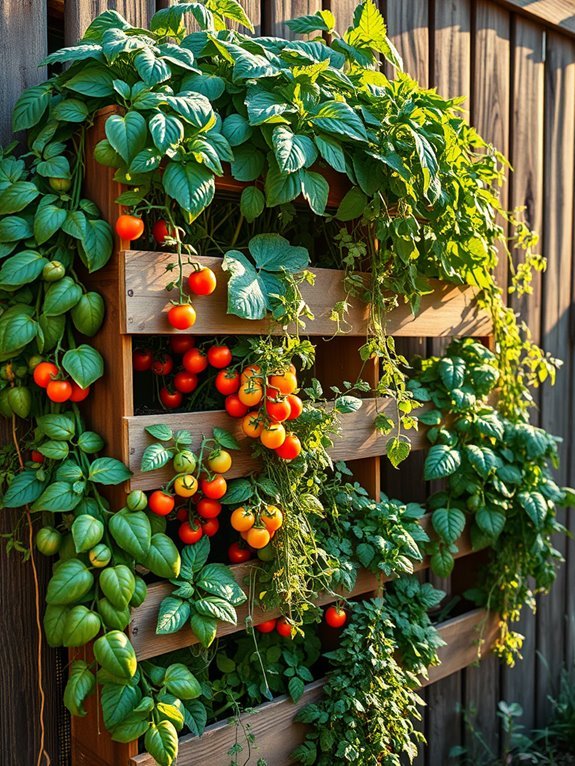
Vertical gardening is an innovative way to utilize small spaces, transforming bare walls or fences into lush green landscapes. You can create a stunning vertical garden using wall planters, trellises, or repurposed pallets.
Select plants that thrive vertically, such as climbing beans, tomatoes, or vibrant herbs, which not only enhance beauty but also provide fresh produce. This gardening method also helps deter pests, like squirrels.
Vertical gardening maximizes sunlight exposure for strong, healthy plants. Experiment with different heights and arrangements for a creative touch, and consider adding decorative elements like fairy lights or garden art to personalize your space.
Impress friends with a stylish and productive vertical garden. Grab your tools and elevate your gardening game—time to go up!
Container Gardening
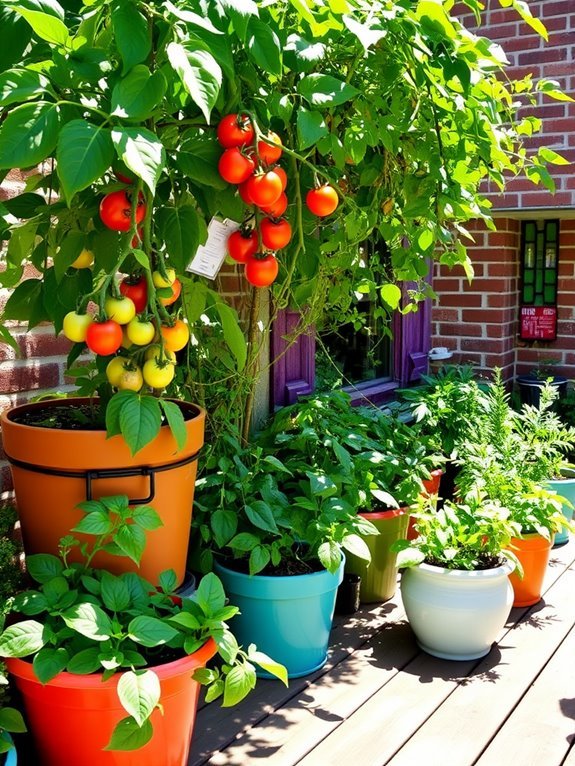
Container gardening is an excellent option for those with limited space or poor soil, enabling you to grow various plants on your patio, balcony, or indoors. Imagine harvesting fresh tomatoes or aromatic peppers steps from your kitchen! You can utilize pots, buckets, or even old shoes, ensuring they've good drainage.
Begin with easy-to-grow plants like herbs, lettuce, or radishes, which thrive in containers and require minimal space. Consider material choices for your containers—terracotta, plastic, and ceramic all work well. Larger pots can hold more soil and retain moisture better, reducing the frequency of watering.
Place your containers where they receive ample sunlight, ideally six to eight hours daily, and remember to rotate them for uniform growth.
If you're adventurous, you can try companion planting, as some plants support each other's growth, enhancing your garden's productivity.
Container gardening is both practical and a delightful way to bring greenery into your life! So, get ready to dig in!
Herb Spiral
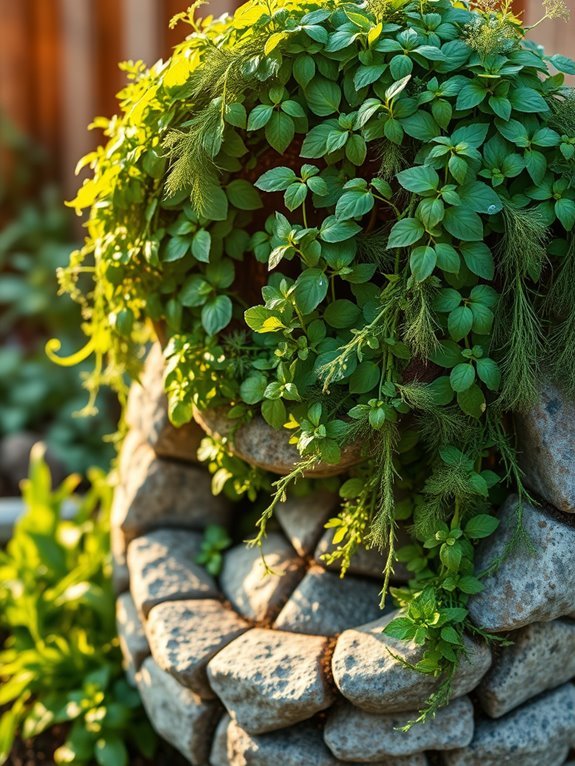
Creating an herb spiral is an excellent way to efficiently use space while growing various herbs in your backyard—a beautiful, edible artwork!
This vertical garden allows for the cultivation of herbs with different light and water needs in a single area, enhancing your outdoor space.
To start your herb spiral, consider these key points:
- Design: Shape it like a spiral using stones or wood.
- Placement: Select a sunny spot, as most herbs prefer sunlight.
- Soil: Use high-quality soil that drains well at the top and retains moisture at the bottom.
- Herbs: Choose a mix of favorites like basil, rosemary, thyme, and mint, each thriving in its ideal location.
- Maintenance: Water as needed and enjoy fresh herb harvests from your spiral!
Straw Bale Gardening
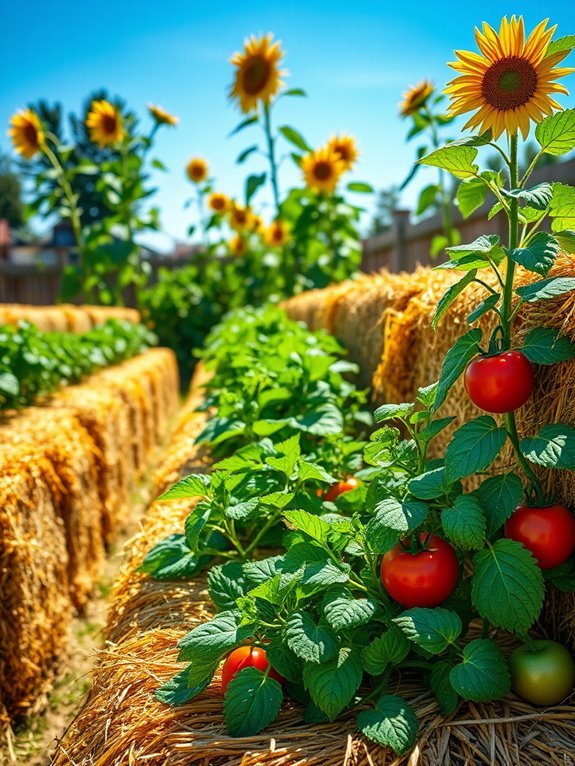
After establishing your herb spiral, consider trying straw bale gardening. This innovative method saves space and offers a unique way to grow fresh veggies using bales of straw as garden beds. They're lightweight and easy to arrange, adding rustic charm to your backyard.
To begin, soak the bales for a few days to break them down, then plant directly into the straw. Crops like tomatoes, cucumbers, and peppers thrive, but feel free to experiment. Just remember to keep the bales well-watered.
Straw bale gardening warms up quickly in spring, allowing you to get an early start on your growing season. It's also ideal for poor soil or limited space.
Plus, it's a quirky gardening method that's sure to impress your friends. So grab your seeds, roll up your sleeves, and enjoy the fresh produce from your straw bales!
Aquaponics Systems
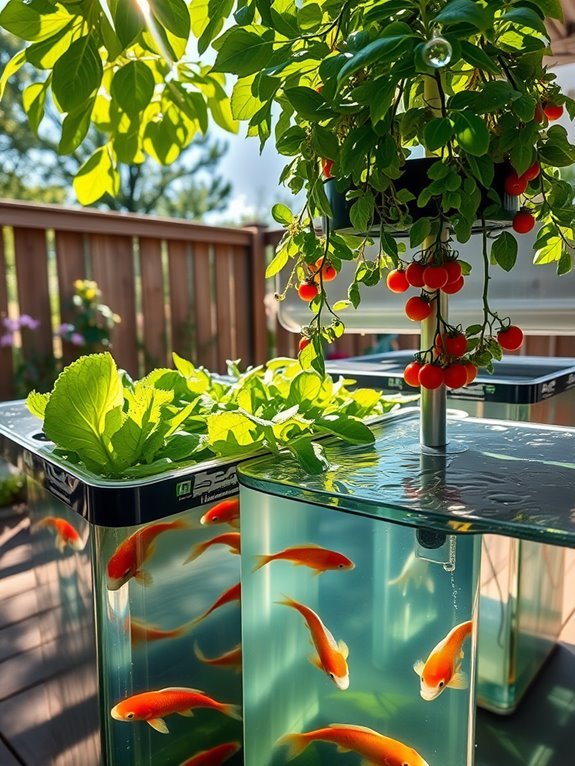
If you've ever wanted to merge fish farming with vegetable gardening, aquaponics systems may be the ideal choice for you.
Picture growing fresh vegetables while raising fish—it's a win-win! In this sustainable setup, fish waste nourishes plants, and the plants purify the water for the fish, creating a delightful cycle that can enhance your backyard.
Here are key considerations when starting an aquaponics system:
- Space: A small corner of your yard will suffice.
- Fish Choice: Select from tilapia, goldfish, or catfish—whatever you prefer!
- Plants: Lettuce, herbs, and tomatoes thrive in this environment.
- System Type: Choose between flood-and-drain, deep water culture, or media beds.
- Maintenance: Generally low-maintenance—fish keep the system interesting!
Setting up an aquaponics system can be an enjoyable venture.
You'll experience unique gardening while savoring homegrown produce and fresh fish.
Hydroponic Gardening
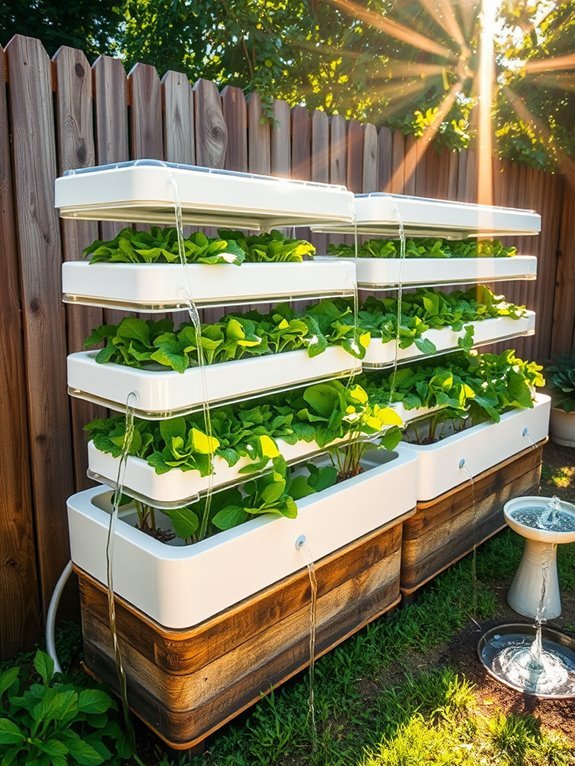
Hydroponic gardening enhances soil-less cultivation by enabling you to grow plants in a nutrient-rich water solution. Imagine a backyard filled with fresh herbs, juicy tomatoes, and crisp lettuce—thriving without dirt!
In hydroponics, you can create a system that circulates water infused with essential nutrients, eliminating concerns about weeds or poor soil quality. Your plants absorb nutrients directly from the water, and this method can be utilized both indoors and outdoors.
Explore various methods like deep water culture or nutrient film techniques to find what suits you best. If space is limited, a vertical garden setup can be very effective.
One of the greatest advantages of hydroponics is the ability to grow year-round, ensuring you won't experience a tomato-less summer.
Plus, who wouldn't want to impress friends with homegrown salad ingredients? Dive into hydroponic gardening and let your green thumb flourish!
Square Foot Gardening
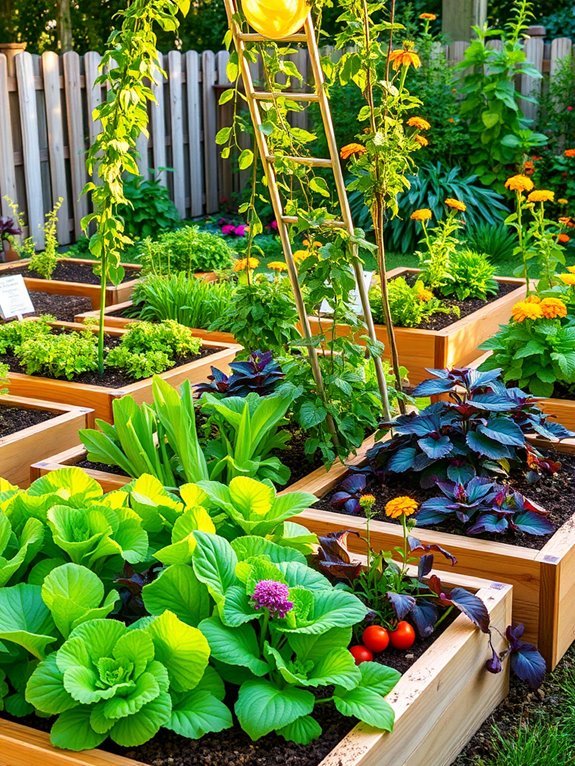
Square foot gardening is an excellent way to optimize your backyard for growing a variety of vegetables and herbs.
It's straightforward, efficient, and perfect for beginners. You can create a mini-garden in a small area by dividing your garden into 1-foot square sections for planting different crops.
Follow these simple steps to start:
- Choose your location: Find a sunny spot.
- Build your grid: Use wood or string to make 1-foot squares.
- Select your crops: Choose veggies and herbs you enjoy.
- Plant intensively: Maximize yield by planting densely in each square.
- Enjoy the harvest: Watch your garden thrive and savor the fresh produce!
Square foot gardening saves space and allows for experimentation with various plants, all without needing extensive gardening knowledge.
Grab your seeds and start cultivating your backyard oasis!
Companion Planting
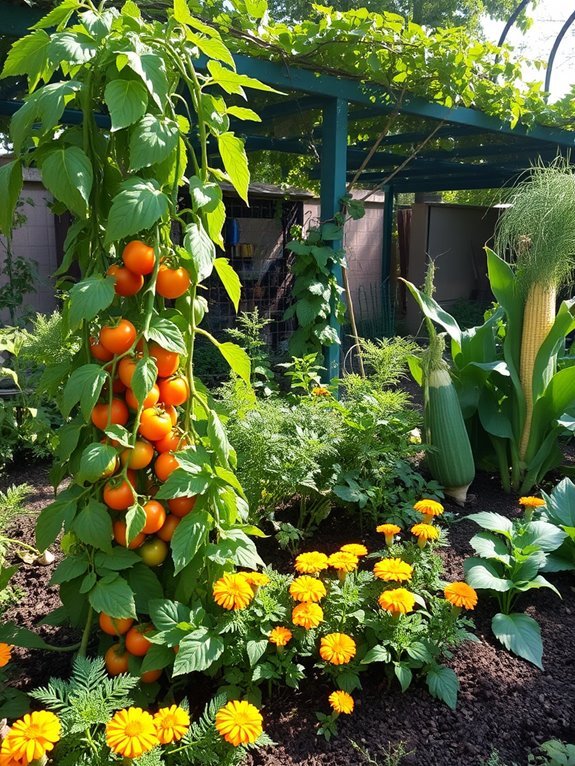
Companion planting can significantly boost your garden's productivity and health by pairing plants that benefit each other. For example, planting tomatoes with basil enhances tomato flavor and repels pests, acting as a natural bodyguard.
Consider adding marigolds near vegetables; their vibrant flowers attract beneficial insects while deterring harmful ones.
And if you want to venture further, try the "Three Sisters" method—planting corn, beans, and squash together—creating a supportive mini-ecosystem.
Don't hesitate to experiment! Mix and match plants for surprising benefits, but avoid combinations like onions and beans that don't coexist well.
Companion planting helps improve garden health, minimize pests, and adds enjoyment to your gardening experience. Happy planting, and may your garden thrive!
Edible Landscaping
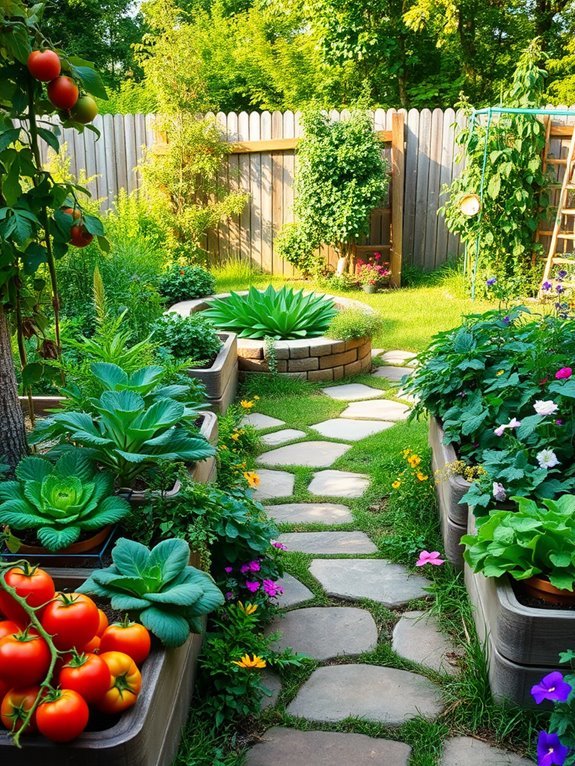
Landscaping is often seen as purely decorative, but incorporating edible plants can turn your yard into a productive space. Imagine harvesting fresh herbs or vegetables whenever you need them—it's practical and enjoyable!
Start blending edible plants with traditional landscaping. Here are some ideas:
- Herb borders: Use aromatic rosemary and thyme as attractive edging plants.
- Veggie beds: Create raised beds featuring colorful carrots, beets, and lettuce.
- Berry bushes: Plant blueberries and raspberries for tasty treats and vibrant foliage.
- Edible ground covers: Opt for creeping thyme or strawberries for flavor and charm.
- Flowering kale: It looks gorgeous and adds a delicious twist to salads!
With a bit of creativity, you can create a yard that's both beautiful and functional. Impress your friends with salads made from your own garden—who said landscaping couldn't be delicious?
Dive into edible landscaping and watch your garden flourish!
Fruit Trees
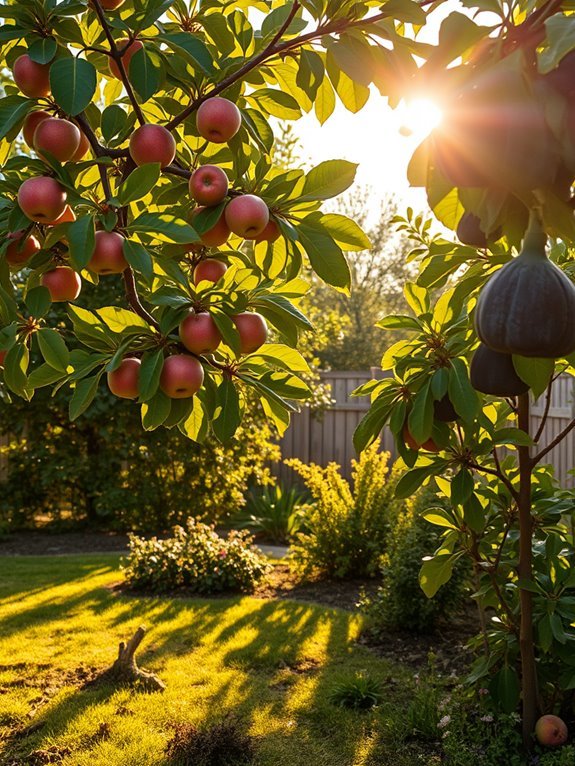
Planting fruit trees in your backyard not only enhances beauty but also provides fresh produce. Imagine picking juicy apples or sweet peaches from your garden—it's like having a mini orchard!
Selecting the right trees is essential based on their sunlight needs. Here's a quick guide:
| Fruit Tree | Sunlight Requirement |
|---|---|
| Apple | Full Sun |
| Peach | Full Sun |
| Cherry | Full Sun |
| Plum | Partial Shade |
Consider the space each tree requires to prevent competition for sunlight. Don't forget to water regularly, especially during dry spells. With patience, your trees will yield bountiful harvests. Grab your gardening gloves and start planting! You'll be delighted by the joy these trees bring to your backyard. 🍏🌳
Pollinator Gardens
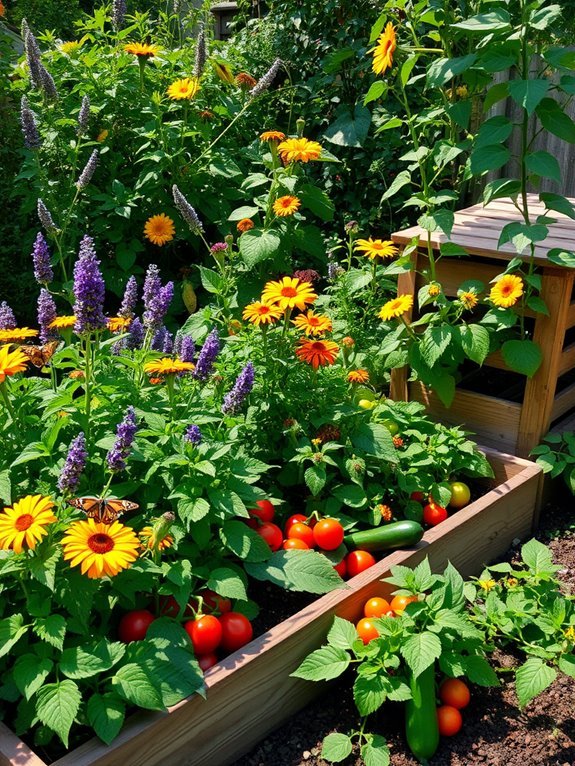
After planting fruit trees, enhance your backyard ecosystem by creating a pollinator garden. Attract bees, butterflies, and hummingbirds while boosting fruit production—it's a win-win!
Choose a sunny spot and plant a variety of flowers that bloom at different times:
- Lavender: Beautiful and fragrant.
- Coneflower: Hardy and appealing to pollinators.
- Bee Balm: Loved by bees, butterflies, and hummingbirds.
- Sunflowers: Cheerful and tall.
- Milkweed: Essential for monarch butterflies and adds color.
Mixing diverse plants will keep your garden vibrant and lively.
The more variety, the more pollinators you'll attract. Enjoy the sight of butterflies dancing around your flourishing garden!
Composting
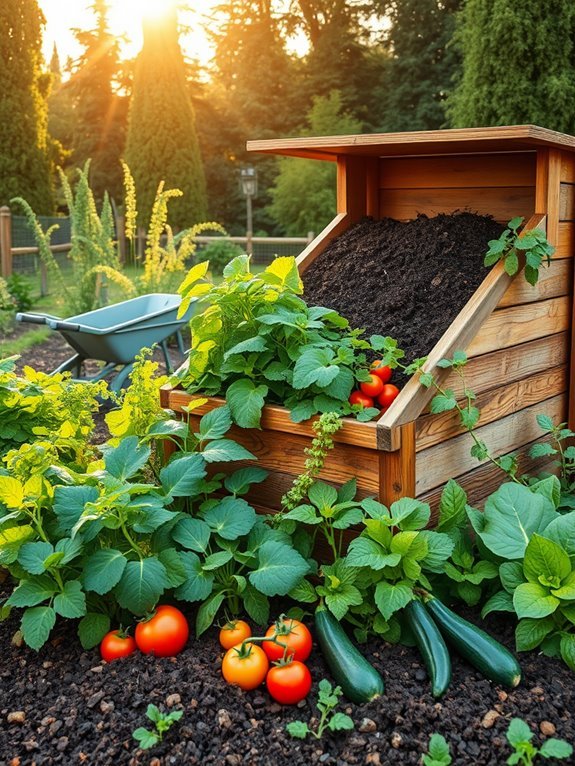
Composting reduces waste and enriches garden soil, making it a sustainable option for backyard farming. Instead of tossing kitchen scraps, transform them into nutrient-rich compost by layering organic waste in a compost bin or a corner of your yard.
Use items like fruit peels, vegetable scraps, coffee grounds, and shredded paper, but avoid meat and dairy to prevent attracting unwanted critters.
As the compost breaks down, it will create rich soil that benefits your plants, providing them with essential nutrients. In just a few months, you'll have dark, crumbly compost to help your vegetables thrive.
Plus, composting contributes to reducing landfill waste, benefiting the environment.
There's a rewarding satisfaction in turning waste into a valuable resource. So, get your hands dirty and dive into the rewarding practice of composting. Your garden and the planet will appreciate it!
Seasonal Crop Rotation
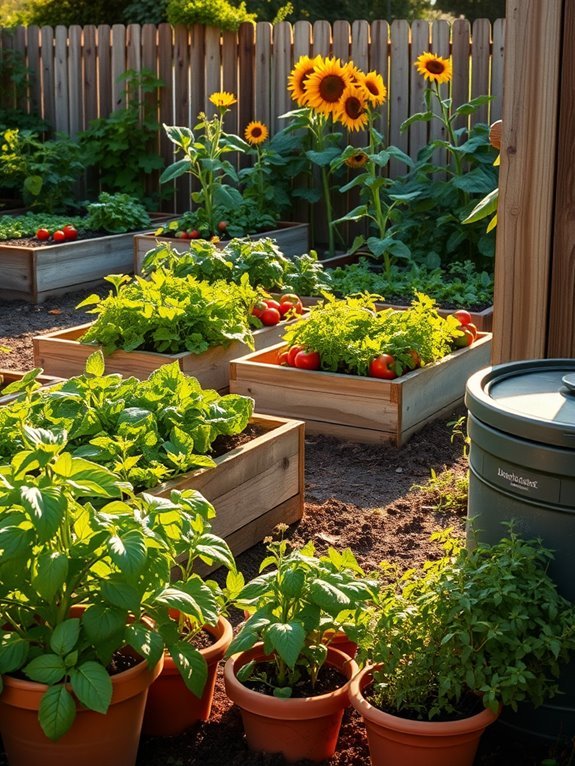
Implementing seasonal crop rotation improves soil health and prevents pest and disease buildup. By changing your crops each season, you allow the soil to replenish nutrients and keep pests uncertain.
Here are some tips to get started:
- Plan your garden layout: Map out your crops to avoid planting the same family in the same location annually.
- Choose diverse crops: Include a variety of vegetables, legumes, and herbs to maintain soil vitality.
- Rotate by plant family: Group plants by family for easier rotation, e.g., switch nightshades (like tomatoes) with legumes (like beans).
- Observe and learn: Note how each crop performs, as some may thrive better in certain areas.
- Have fun with it: Experiment with new varieties each season and embrace creativity!
Frequently Asked Questions
What Pests Should I Watch for in My Backyard Garden?
You'll want to keep an eye out for a few pesky garden invaders!
Aphids can suck the life out of your plants, while caterpillars might munch on your leaves like they're at an all-you-can-eat buffet.
Watch for spider mites, too—they love to spin their webs and cause chaos!
If you spot them, don't panic; a little soapy water or neem oil can work wonders.
Happy gardening, and may your plants thrive!
How Much Space Do I Need for a Backyard Farm?
Think of your backyard as a blank canvas waiting for your green masterpiece!
You don't need a sprawling estate to start a backyard farm. Just a small space, like 10 by 10 feet, can work wonders.
You'll have room for herbs, veggies, and maybe even a fruit bush or two.
Start small, and as you get the hang of it, you can always expand.
Who knew farming could fit in your pocket?
What Tools Are Essential for Backyard Gardening?
When you plunge into gardening, having the right tools makes all the difference!
You'll want a sturdy trowel for digging, a hand rake for aerating soil, and some pruners to keep your plants in check.
Don't forget gloves to protect your hands from dirt and thorns! A watering can or hose is essential, too.
With these tools, you'll be a gardening superstar in no time, growing your green thumb with joy!
Can I Garden in Shaded Areas of My Yard?
Absolutely, you can garden in shaded areas of your yard!
While full sun is ideal for many plants, some thrive in shade. Think leafy greens, like spinach and lettuce, or even herbs like mint and parsley.
Just remember, they won't grow as quickly as those sunbathers. So, don't despair!
Embrace your shady spots, and you might just discover a hidden garden treasure. Who knew shade could be so productive?
Happy gardening!
How Do I Choose the Right Soil for My Plants?
Imagine your plants chatting like old pals over a cup of coffee, discussing the best soil for their new digs.
To choose the right soil, think about what your plants love. For veggies, go for rich, loamy soil that drains well.
If you're planting flowers, consider a mix that retains moisture but doesn't drown them.
Don't forget to add organic matter for nutrients! Your plants will thank you by growing like champs!
Conclusion
Here are 14 delightful backyard farming ideas to bring joy into your life while growing fresh produce. From cozy herb spirals to charming fruit trees, your garden can transform into a vibrant paradise. Incorporating a variety of plants not only adds visual appeal but also promotes biodiversity in your garden. For those new to gardening, consider researching small backyard vegetable garden tips to maximize your space efficiently and effectively. With a little creativity and effort, you can cultivate a thriving oasis that provides fresh ingredients for your meals.
It's more than just veggies; it's about the laughter, dirt under your nails, and the satisfaction of nurturing life. So grab your shovel, and let's embark on this adventure together!

